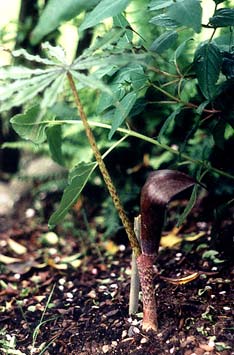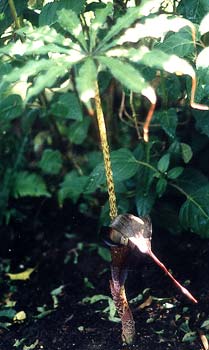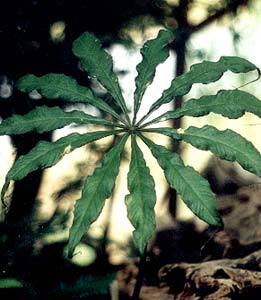
Formosan Jack-in-the-Pulpit
I planted a Formosan Jack-in-the-Pulpit (Arisaema taiwanensis) in a shady in April (2002), when it was a tiny pointed stub rather similar to a newly erupted hosta. By May as shown in the first photo, it had raised up its going-on-two-feet high umbrella beneath which it opened its fat ten inch tall pulpit.
By then it was obvious that it was facing the wrong direction for us to be able to look into the pulpet. So after momentary debate with Granny Artemis as to whether or not to upset it by turning it around, I did turn it to face outward to the path, which disruption fortunately didn't seem to hinder it one bit. The second photo from the new angle was taken in early June.
Planted nearby are two specimens of A. triphyllum, the American Jack-in-the-Pulpit, which blooms a month before the Formosan. The American Arisaema has a much simpler umbrella of only three leaves, hence the species name triphyllum or three-leaf. Another species in our collection is A. tosaense with yet another leaf arrangement of largish leaves divided into an appearance of being several smaller leaves.
 Of the Arisaemas in our garden, A. taiwanensis is the only one with a completely circular Robinson Crusoe umbrella, made up of fifteen leaves. The umbrella has a persistant presence all through summer & well into autumn. The third photo on this page shows this umbrella in September. In 2003, this same plant lasted until the second week of October, when the thick stem finally weakened & tipped over.
Of the Arisaemas in our garden, A. taiwanensis is the only one with a completely circular Robinson Crusoe umbrella, made up of fifteen leaves. The umbrella has a persistant presence all through summer & well into autumn. The third photo on this page shows this umbrella in September. In 2003, this same plant lasted until the second week of October, when the thick stem finally weakened & tipped over.The purple-black pulpit enwraps a ghostly white Jack; it'd be a nice choice for a "Gothic Garden" of black or nearly-black flowers.
The leaves can easily grow to three feet in the air though ours only reached two feet so far; it'll likely be bigger in years to come. One needs a small colony if they are to pollinate, & early in 2003 we added a second one. Additional portraits of both specimens can be seen on the A. taiwanensis page of the Pulpit Gallery.
 We have not thus far had them berry. When they do pollinate one another, the long-lasting pulpit eventually peels away revealing a large fruit vaguely like a corncob with each tightly packed berry yellow-green with a red-brown spot. It is best to remove this at least for the first year, as the fruit will not produce viable seeds until it is a few years old, & a young plant will expend too much energy sustaining the fruit & not establish itself so well.
We have not thus far had them berry. When they do pollinate one another, the long-lasting pulpit eventually peels away revealing a large fruit vaguely like a corncob with each tightly packed berry yellow-green with a red-brown spot. It is best to remove this at least for the first year, as the fruit will not produce viable seeds until it is a few years old, & a young plant will expend too much energy sustaining the fruit & not establish itself so well.When seeds are eventually permitted, they can be harvested & planted in a protected environment, ideally in pots placed in a spot that receives a little morning sunlight. They develop rapidly & will even bloom the very first spring, unlike most jack-in-the-pulpit species that take a couple years to develop.
This species has not been long in western gardens. Ours is from the seed of specimens collected in Taiwan by Bleddyn & Sue Wynne-Jones of Crugg Farms in northern Wales. Their friend Dan Hinkley runs a nursery very near where we live on Puget Sound, & after he made limited numbers available locally, a handful of other growers began producing them. I presume the species is making its way slowly cross-country & will in a short time be popularly available in every zone that can grow jack-in-the-pulpits.
Shikoku Island Cobra Lily
(A. tosaense)